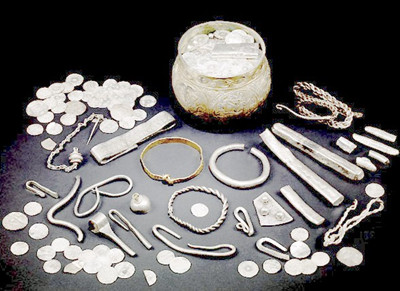The Vale of York hoard makes it clear that Viking England did indeed operate on a trans-continental scale. Here is a dirham from Samarkand, and there are other Islamic coins from central Asia. Like York, Kiev was a great Viking city, and there merchants from Iraq, Iran and Afghanistan traded their goods via Russia and the Baltic to the whole of northern Europe. In the process, the people around Kiev became very rich. An Arab merchant of the time describes them making neck-rings for their wives by melting down the gold and silver coins they'd amassed from trade:
約克郡的寶藏表明,維京人確實一度在整個歐洲大陸經商。寶藏中有一枚撒馬爾罕的貨幣迪拉姆,也有一些來自中亞的伊斯蘭貨幣,基輔與約克一樣是維京人盤踞的重要城市,來自伊拉克、伊朗和阿富汗的商人在這里取道俄羅斯和波羅的海,將貨物銷往整個北歐。居住在基輔周邊的人因而變得富裕。當時的一名阿拉伯商人說,這里的人熔化貿易所得的金銀幣,為妻子制作項圈:
"Round her neck she wears gold or silver rings; when a man amasses 10,000 dirhams, he makes his wife one ring; when he has 20,000 he makes two... and often a woman has many of these rings."
女人戴著金銀項圈,男人一旦攢夠一萬牧迪拉姆,就會給妻子打一個項圈,兩萬牧就打兩個…一個女人通常擁有多個項圈。
And, indeed, there's a fragment of one of these Russian rings in the hoard.
寶藏中確實有一塊這種俄羅斯項圈的殘片。
Although Kiev and York were both Viking cities, contact between them would only very rarely have been direct. Normally the trade route would be constructed through a series of relays, with spices and silver coins and jewellery moving north, as amber and fur moved in the other direction, and at every stage there would be a profit. But this trade route also carried the dark side of the Vikings' reputation. All through eastern Europe, the Vikings captured people to sell as slaves in the great market of Kiev-which explains why in so many European languages the words for slave and Slav are to this day still so closely connected.
基輔和約克都是維京人的城市,但它們之間幾乎沒有過直接交流。貿易路線上通常會有好幾個中轉站,商人到這里將香料、銀幣和珠寶運往北方,再將琥珀和皮草運往南方,每次轉手都能賺上一筆。這條貿易路線也讓維京人惡名遠揚。他們在整個東歐到處抓人,運到基輔的奴隸市場上販賣。也因此,在很多歐洲語言中,指代“奴隸” (slave)和“斯拉夫人”(Slav)的詞語仍高度相關。
譯文屬可可原創,僅供學習交流使用,未經許可請勿轉載












